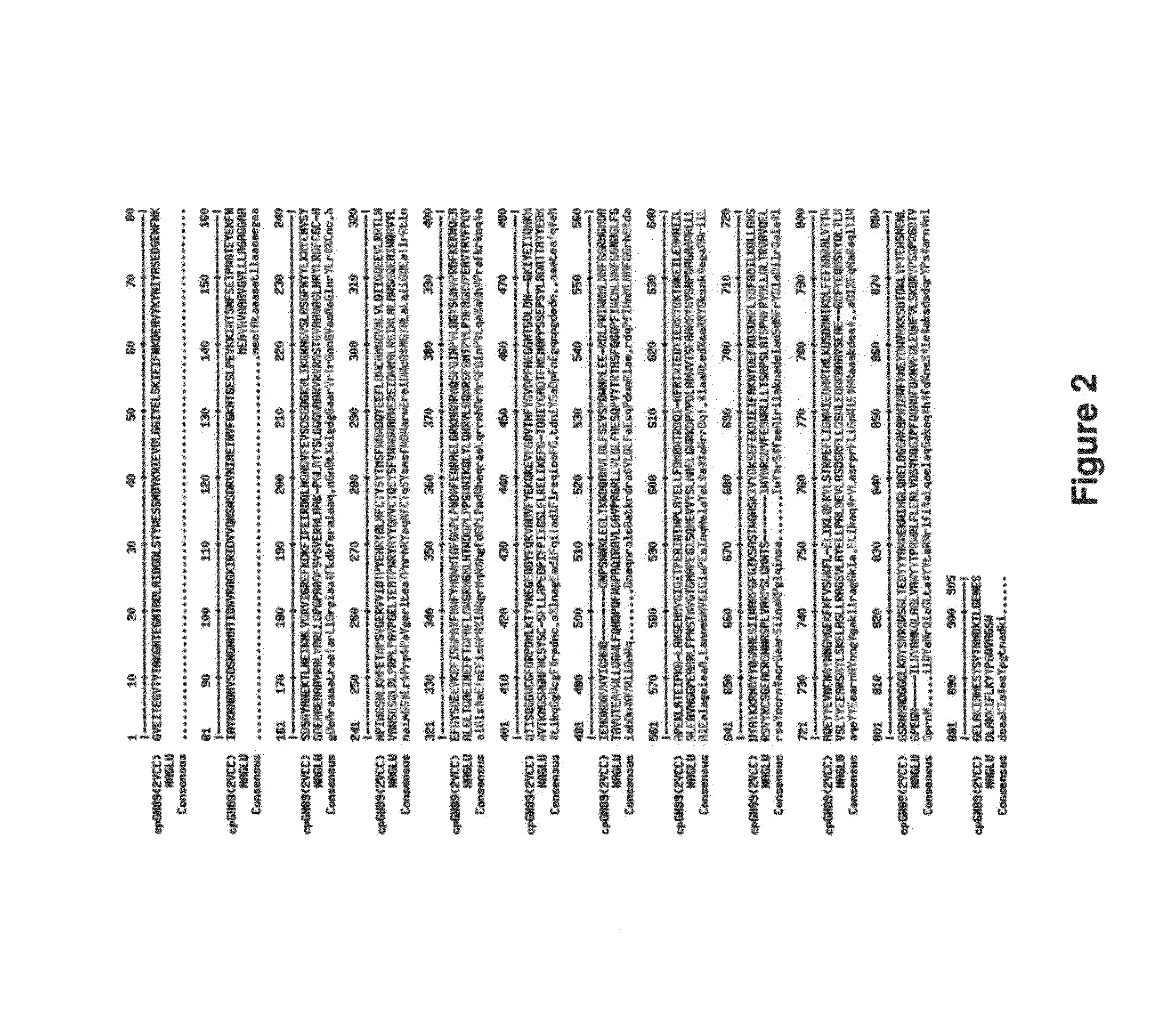Crystal structure of human alpha-n-acetylglucosaminidase
a technology of alphanacetylglucosaminidase and crystal structure, which is applied in the field of crystal structure of human alphanacetylglucosaminidase, can solve the problems of difficult treatment and high cost, and achieve the effect of reducing the activity of naglu and alleviating some of the associated symptoms
- Summary
- Abstract
- Description
- Claims
- Application Information
AI Technical Summary
Benefits of technology
Problems solved by technology
Method used
Image
Examples
example 1
Crystallization and Structure Determination of NAGLU
[0137]Described herein is the crystallization and determination of structure of α-N-acetylglucosaminidase (NAGLU) at a resolution of 2.9 Å and 2.4 Å by X-ray crystallography.
1.1. Experimental Design
[0138]NAGLU was expressed in HT1080 cells that were cultured at 37° C. to 2-3 million cells per mL. The temperature was decreased to 33° C. and the culture was treated with 2.5 mg / L of kifunensine (a mannosidase I inhibitor). Conditioned media containing secreted NAGLU was harvested 48 hours after starting kifunensine treatment. The resulting protein is abbreviated as Naglu-kif. Secreted protein was purified from culture media by hydrophobic butyl column followed by anion exchange Q column (as described in Example 3).
[0139]While purifying NAGLU-kif, a fine precipitate appeared at the final concentrating step. At this stage the protein was in Q column buffer which is 20 mM Tris pH=7.5 and approximately 100 mM NaCl. The precipitation start...
example 2
2.1 Crystallization and Cryo Protection
[0149]Initial crystals of Naglu-kif were obtained when purified protein was concentrated above 1 mg / mL. These crystals were confirmed to be made of NAGLU protein by testing the crystals in X-ray diffraction at room temperature. These crystals were too small to collect a complete data set and were diffracting to only ˜3.5 Å after 30 min exposure per frame. Radiation damage of protein crystal occurred due to long exposure on X-ray beam at room temperature that resulted in poor diffraction resolution in subsequent frames. Moreover the higher solvent content (about 80%) in the crystals caused damage to the crystal due to shock when transferred into cryo-buffer. These issues warranted further optimization of crystallization and cryo-protection in order to get a complete diffraction data set.
[0150]Naglu-kif R3 was dialyzed overnight against 20 mM Tris pH=7.5 and 100 mM NaCl and concentrated to 1.2 mg / mL. Crystallization screening was done for Naglu-k...
example 3
Expression and Purification of NAGLU-Kif
[0163]Described in this Example is the expression in HT1080 cells and purification of NAGLU-kif, a recombinant human α-N-acetylglucosaminidase, cultured in a medium containing kifunensine, a potent inhibitor of alpha-mannosidase I.
3.1. Experimental Design
[0164]Naglu clone SP3-10D was scaled up for protein purification in shake flasks using CD-GLD-02 media. A 5 L working volume was seeded at 730,000 viable cells / mL and perfused at 5 L / day for a total of 4 days at 37° C. in growth phase. A transition phase of 24 hours was used to allow incorporation of the CD-GLD-02 media supplemented with 2 mg / L kifunensine at 33° C. Kifunensine is a potent inhibitor of alpha-mannosidase I. alpha-Mannosidase I catalyzes the removal of terminal, non-reducing alpha-D-mannose from high mannose glycan, which precede the formation of complex glycans. Proteins produced in cells treated with Kifunensine exhibit reduced content of complex N-linked oligosaccharides and ...
PUM
 Login to View More
Login to View More Abstract
Description
Claims
Application Information
 Login to View More
Login to View More - R&D
- Intellectual Property
- Life Sciences
- Materials
- Tech Scout
- Unparalleled Data Quality
- Higher Quality Content
- 60% Fewer Hallucinations
Browse by: Latest US Patents, China's latest patents, Technical Efficacy Thesaurus, Application Domain, Technology Topic, Popular Technical Reports.
© 2025 PatSnap. All rights reserved.Legal|Privacy policy|Modern Slavery Act Transparency Statement|Sitemap|About US| Contact US: help@patsnap.com



